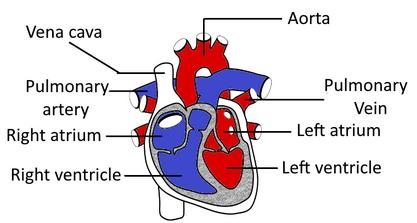
The diagram given represents the human heart in one phase of its functions. Stud the diagram carefully and answer the questions that follow:
(i) Name the phase.
(ii) Which part of the heart is contracting in this phase? Give a reason to support your answer.
(iii) Name the parts labeled 1 to 4.
(iv) What type of blood flows through ‘2’?
(v) State the function of the part ‘5’.
(vi) Name the membrane that covers the heart?


Answer
433.2k+ views
Hint: It is an organ that pumps blood through the blood vessels of the circulatory system. It is the body's pumping organ that pumps blood to every part of the body. The muscle is smooth and is involuntary in nature.
Complete answer:
In this phase, the heart undergoes ventricular systole. The systolic phase is the time of contraction of the ventricles that takes place and pushes the blood into the aorta and pulmonary artery.
-The cardiac cycle is of 7 parts which are P wave (atrial deposition) then the second phase, the third phase, and the fourth phases are of the systolic phase and the fifth phase, the sixth phase, and the seventh phase are of the diastolic phase which repeats with P wave.
-The heartbeat is produced when the sound of Lubb and Dubb is produced. The Lubb sound is produced first by the heart when the ventricular waves contract and the atrioventricular valves close. It takes place when the ventricular contraction behind during the ventricular systole. While the second sound Dub is produced by the heart when the flow of blood occurs. It takes place when the ventricles are relaxed and the aortic pulmonary valves get closed. This time period between the two sounds of the heart that is from dup to lub is called the diastole.

Note:
The blood flows into the ventricle with the help of the two valves that are the tricuspid valves and the bicuspid valves. The bicuspid and tricuspid valves together form the atrioventricular valves of the heart. The parts labeled 1 to 4 are the Pulmonary artery, aorta, bicuspid valve, and semilunar valve. From part ‘2’ flow of oxygenated blood occurs. Part ‘5’ is a semilunar valve that prevents the backflow of blood. The pericardium is the name of the membrane that covers the heart.
Complete answer:
In this phase, the heart undergoes ventricular systole. The systolic phase is the time of contraction of the ventricles that takes place and pushes the blood into the aorta and pulmonary artery.
-The cardiac cycle is of 7 parts which are P wave (atrial deposition) then the second phase, the third phase, and the fourth phases are of the systolic phase and the fifth phase, the sixth phase, and the seventh phase are of the diastolic phase which repeats with P wave.
-The heartbeat is produced when the sound of Lubb and Dubb is produced. The Lubb sound is produced first by the heart when the ventricular waves contract and the atrioventricular valves close. It takes place when the ventricular contraction behind during the ventricular systole. While the second sound Dub is produced by the heart when the flow of blood occurs. It takes place when the ventricles are relaxed and the aortic pulmonary valves get closed. This time period between the two sounds of the heart that is from dup to lub is called the diastole.

Note:
The blood flows into the ventricle with the help of the two valves that are the tricuspid valves and the bicuspid valves. The bicuspid and tricuspid valves together form the atrioventricular valves of the heart. The parts labeled 1 to 4 are the Pulmonary artery, aorta, bicuspid valve, and semilunar valve. From part ‘2’ flow of oxygenated blood occurs. Part ‘5’ is a semilunar valve that prevents the backflow of blood. The pericardium is the name of the membrane that covers the heart.
Recently Updated Pages
Master Class 9 General Knowledge: Engaging Questions & Answers for Success

Master Class 9 English: Engaging Questions & Answers for Success

Master Class 9 Science: Engaging Questions & Answers for Success

Master Class 9 Social Science: Engaging Questions & Answers for Success

Master Class 9 Maths: Engaging Questions & Answers for Success

Class 9 Question and Answer - Your Ultimate Solutions Guide

Trending doubts
According to Bernoullis equation the expression which class 11 physics CBSE

A solution of a substance X is used for white washing class 11 chemistry CBSE

10 examples of friction in our daily life

Simon Commission came to India in A 1927 B 1928 C 1929 class 11 social science CBSE

Difference Between Prokaryotic Cells and Eukaryotic Cells

Can anyone list 10 advantages and disadvantages of friction




